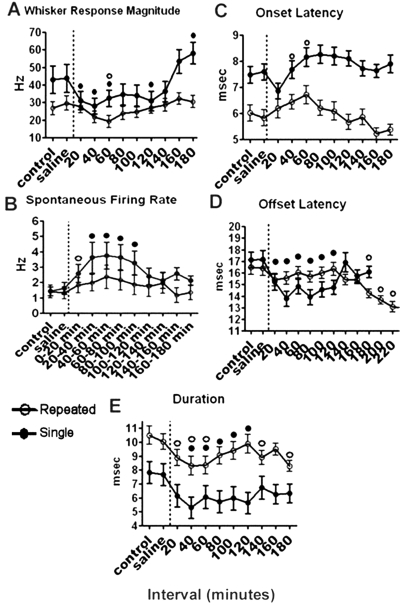Fig. 5.
A, effects of single versus repeated MDMA administration on VPM thalamic unit responsiveness (peak E1) to mechanical whisker deflection. A single (3 mg/kg) MDMA administration decreased responsiveness to medium- and high (data not shown)-intensity whisker stimulation 10 to 120 min after drug and increased responsiveness at 160 to 180 min after drug administration. A challenge injection of MDMA (3 mg/kg) after repeated drug administration (3 mg/kg for 4 days) led to a reduction in the response magnitude (peak E1) to medium- and high (data not shown)-intensity whisker stimulation, respectively. Unlike the single drug treatment condition, MDMA's effects on whisker responsiveness to high-intensity whisker stimulation were blunted after repeated MDMA administration. B, effects of single versus repeated MDMA administration on the SFR of neurons in the VPM thalamus. Acute MDMA administration led to an increased level of spontaneous firing during medium- and high (data not shown)-intensity whisker stimulation, followed by a return to control levels. Repeated MDMA administration increased the spontaneous firing rate of individual neurons during medium- and high (data not shown)-intensity whisker stimulation, followed by a return to control levels, respectively. However, after repeated MDMA administration, the effects on spontaneous firing were blunted compared with those for acute, single-dose treatment. C, effects of single versus repeated MDMA administration on the onset latency of the response. Single administration of MDMA had no significant effect on the onset latency of the whisker-evoked response. A challenge injection of MDMA after repeated MDMA administration led to an increase in the onset latency during medium- and high (data not shown)-intensity whisker stimulation, respectively. However, the onset latency to medium- and high (data not shown)-intensity whisker stimulation was shorter during the control period after repeated MDMA administration compared with that observed in the drug-naive animal. D, effects of single versus repeated MDMA administration on the offset latency of the response. MDMA administration led to an initial decrease in the offset latency during medium- and high (data not shown)-intensity whisker stimulation. A challenge injection of MDMA after repeated MDMA administration led to a significant decrease in the offset latency after repeated MDMA administration, but this effect was observed only during the last 60 min of the recording session. MDMA's effects on offset latency appear to be greater in the single-treatment animals. E, effects of single versus repeated MDMA administration on the duration of the response. Single administration of MDMA decreased the duration of the whisker-evoked response during medium- and high (data not shown)-intensity whisker stimulation. Repeated MDMA administration also decreased the duration of the whisker-evoked response during medium- and high (data not shown)-intensity whisker stimulation. The dashed vertical lines indicate the time of MDMA injection. ● and ○, significant changes from control after single versus repeated MDMA administration, respectively (Dunnett's post hoc test, p > 0.05). (Single administration data are taken from Starr et al., 2008.).

